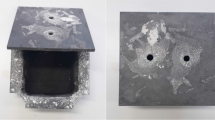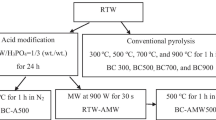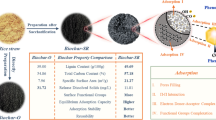Abstract
Deriving biochar from biowaste facilitates its reuse and application for environmental protection. This study addresses the adsorption of phenol onto food waste–based biochar (FWC). Phenol adsorption on FWC was affected by pyrolysis temperature, and the highest adsorption capacity was found at a temperature of 700 °C (FWC700). The characteristics of the biochar including morphology, surface area, functional groups, and elemental composition were analyzed. Additional batch experiments were performed to evaluate the phenol adsorption on FWC700 under various experimental conditions such as contact time, initial concentration, reaction temperature, solution pH, adsorbent dose, and presence of competing ions. The adsorption capacity of phenol decreased gradually from 9.79 ± 0.04 to 8.86 ± 0.06 mg/g between solution pH of 3 and 11. Copper sulfate showed the greatest interference on phenol adsorption to FWC in aqueous solution. Phenol removal at different contact times followed pseudo-second-order kinetics, and the Langmuir isotherm model provided the best fit of the equilibrium data with a maximum adsorption capacity of 14.61 ± 1.38 mg/g. Adsorption of phenol increased with increasing temperature from 15 to 35 °C, and thermodynamic analysis indicated an endothermic and spontaneous nature of the adsorption process. Biochar derived from food waste can be used as bio-adsorbent for the removal of phenol from aqueous solution.












Similar content being viewed by others
References
Ahmad, M., Lee, S. S., Dou, X., Mohan, D., Sung, J. K., Yang, J. E., et al. (2012). Effects of pyrolysis temperature on soybean stover- and peanut shell-derived biochar properties and TCE adsorption in water. Bioresource Technology, 118, 536–544. https://doi.org/10.1016/j.biortech.2012.05.042.
Arafat, H. A., Franz, M., & Pinto, N. G. (1999). Effect of salt on the mechanism of adsorption of aromatics on activated carbon. Langmuir : the ACS journal of surfaces and colloids, 15(18), 5997–6003.
Bekkouche, S., Baup, S., Bouhelassa, M., Molina-Boisseau, S., & Petrier, C. (2012). Competitive adsorption of phenol and heavy metal ions onto titanium dioxide (Dugussa P25). Desalination and Water Treatment, 37(1–3), 364–372.
Calace, N., Nardi, E., Petronio, B., & Pietroletti, M. (2002). Adsorption of phenols by papermill sludges. Environmental Pollution, 118(3), 315–319.
Cely, P., Tarquis, A. M., Paz-Ferreiro, J., Méndez, A., & Gascó, G. (2014). Factors driving the carbon mineralization priming effect in a sandy loam soil amended with different types of biochar. Solid Earth, 5(1), 585–594. https://doi.org/10.5194/se-5-585-2014.
Chen, B., & Chen, Z. (2009). Sorption of naphthalene and 1-naphthol by biochars of orange peels with different pyrolytic temperatures. Chemosphere, 76(1), 127–133. https://doi.org/10.1016/j.chemosphere.2009.02.004.
Chen, B., Zhou, D., & Zhu, L. (2008). Transitional adsorption and partition of nonpolar and polar aromatic contaminants by biochars of pine needles with different pyrolytic temperatures. Environmental Science & Technology, 42(14), 5137–5143.
Chen, Z., Chen, B., Zhou, D., & Chen, W. (2012). Bisolute sorption and thermodynamic behavior of organic pollutants to biomass-derived biochars at two pyrolytic temperatures. Environmental Science & Technology, 46(22), 12476–12483. https://doi.org/10.1021/es303351e.
Cui, Y., Liu, X. Y., Chung, T. S., Weber, M., Staudt, C., & Maletzko, C. (2016). Removal of organic micro-pollutants (phenol, aniline and nitrobenzene) via forward osmosis (FO) process: evaluation of FO as an alternative method to reverse osmosis (RO). Water Research, 91, 104–114. https://doi.org/10.1016/j.watres.2016.01.001.
Demirbas, A. (2004). Effects of temperature and particle size on bio-char yield from pyrolysis of agricultural residues. Journal of Analytical and Applied Pyrolysis, 72(2), 243–248. https://doi.org/10.1016/j.jaap.2004.07.003.
Dong, X., Ma, L. Q., Zhu, Y., Li, Y., & Gu, B. (2013). Mechanistic investigation of mercury sorption by Brazilian pepper biochars of different pyrolytic temperatures based on X-ray photoelectron spectroscopy and flow calorimetry. Environmental Science & Technology, 47(21), 12156–12164. https://doi.org/10.1021/es4017816.
Garcia-Segura, S., Ocon, J. D., & Chong, M. N. (2018). Electrochemical oxidation remediation of real wastewater effluents — a review. Process Safety and Environmental Protection, 113, 48–67. https://doi.org/10.1016/j.psep.2017.09.014.
Gupta, S., Kua, H. W., & Koh, H. J. (2018). Application of biochar from food and wood waste as green admixture for cement mortar. The Science of the Total Environment, 619-620, 419–435. https://doi.org/10.1016/j.scitotenv.2017.11.044.
Hamdaoui, O., & Naffrechoux, E. (2007). Modeling of adsorption isotherms of phenol and chlorophenols onto granular activated carbon Part I. Two-parameter models and equations allowing determination of thermodynamic parameters. Journal of hazardous materials, 147(1–2), 381–394. https://doi.org/10.1016/j.jhazmat.2007.01.021.
Han, Y., Boateng, A. A., Qi, P. X., Lima, I. M., & Chang, J. (2013). Heavy metal and phenol adsorptive properties of biochars from pyrolyzed switchgrass and woody biomass in correlation with surface properties. Journal of Environmental Management, 118, 196–204. https://doi.org/10.1016/j.jenvman.2013.01.001.
Honfi, K., Tálos, K., Kőnig-Péter, A., Kilár, F., & Pernyeszi, T. (2016). Copper (II) and phenol adsorption by cell surface treated Candida tropicalis cells in aqueous suspension. Water, Air, & Soil Pollution, 227(2), 61.
Idrees, M., Batool, S., Kalsoom, T., Yasmeen, S., Kalsoom, A., Raina, S., et al. (2018). Animal manure-derived biochars produced via fast pyrolysis for the removal of divalent copper from aqueous media. Journal of Environmental Management, 213, 109–118. https://doi.org/10.1016/j.jenvman.2018.02.003.
Jain, A. K., Gupta, V. K., Jain, S., & Suhas. (2004). Removal of chlorophenols using industrial wastes. Environmental Science & Technology, 38(4), 1195–1200.
Javed, H., Luong, D. X., Lee, C.-G., Zhang, D., Tour, J. M., & Alvarez, P. J. J. (2018). Efficient removal of bisphenol-A by ultra-high surface area porous activated carbon derived from asphalt. Carbon, 140, 441–448. https://doi.org/10.1016/j.carbon.2018.08.038.
Julcour Lebigue, C., Andriantsiferana, C., N'Guessan, K., Ayral, C., Mohamed, E., Wilhelm, A. M., et al. (2010). Application of sludge-based carbonaceous materials in a hybrid water treatment process based on adsorption and catalytic wet air oxidation. Journal of Environmental Management, 91(12), 2432–2439. https://doi.org/10.1016/j.jenvman.2010.06.008.
Jung, C., Park, J., Lim, K. H., Park, S., Heo, J., Her, N., et al. (2013). Adsorption of selected endocrine disrupting compounds and pharmaceuticals on activated biochars. Journal of Hazardous Materials, 263(Pt 2), 702–710. https://doi.org/10.1016/j.jhazmat.2013.10.033.
Kalderis, D., Kayan, B., Akay, S., Kulaksız, E., & Gözmen, B. (2017). Adsorption of 2,4-dichlorophenol on paper sludge/wheat husk biochar: process optimization and comparison with biochars prepared from wood chips, sewage sludge and hog fuel/demolition waste. Journal of Environmental Chemical Engineering, 5(3), 2222–2231. https://doi.org/10.1016/j.jece.2017.04.039.
Karakoyun, N., Kubilay, S., Aktas, N., Turhan, O., Kasimoglu, M., Yilmaz, S., et al. (2011). Hydrogel–Biochar composites for effective organic contaminant removal from aqueous media. Desalination, 280(1–3), 319–325. https://doi.org/10.1016/j.desal.2011.07.014.
Kim, M. H., & Kim, J. W. (2010). Comparison through a LCA evaluation analysis of food waste disposal options from the perspective of global warming and resource recovery. The Science of the Total Environment, 408(19), 3998–4006. https://doi.org/10.1016/j.scitotenv.2010.04.049.
Kim, T. Y., Cho, S. Y., & Kim, S. J. (2010). Adsorption equilibrium and kinetics of copper ions and phenol onto modified adsorbents. Adsorption, 17(1), 135–143. https://doi.org/10.1007/s10450-010-9306-2.
Kim, Y. S., Jang, J. Y., Park, S. J., & Um, B. H. (2018a). Dilute sulfuric acid fractionation of Korean food waste for ethanol and lactic acid production by yeast. Waste Management, 74, 231–240. https://doi.org/10.1016/j.wasman.2018.01.012.
Kim, H. B., Kim, S. H., Jeon, E. K., Kim, D. H., Tsang, D. C. W., Alessi, D. S., et al. (2018b). Effect of dissolved organic carbon from sludge, rice straw and spent coffee ground biochar on the mobility of arsenic in soil. The Science of the Total Environment, 636, 1241–1248. https://doi.org/10.1016/j.scitotenv.2018.04.406.
Lazo-Cannata, J. C., Nieto-Márquez, A., Jacoby, A., Paredes-Doig, A. L., Romero, A., Sun-Kou, M. R., et al. (2011). Adsorption of phenol and nitrophenols by carbon nanospheres: effect of pH and ionic strength. Separation and Purification Technology, 80(2), 217–224. https://doi.org/10.1016/j.seppur.2011.04.029.
Lee, D. H., Behera, S. K., Kim, J. W., & Park, H. S. (2009). Methane production potential of leachate generated from Korean food waste recycling facilities: a lab-scale study. Waste Management, 29(2), 876–882. https://doi.org/10.1016/j.wasman.2008.06.033.
Lee, C.-G., Park, J.-A., Choi, J.-W., Ko, S.-O., & Lee, S.-H. (2016). Removal and recovery of Cr(VI) from industrial plating wastewater using fibrous anion exchanger. Water, Air, & Soil Pollution, 227(8). https://doi.org/10.1007/s11270-016-2992-y.
Lee, C. G., Javed, H., Zhang, D., Kim, J. H., Westerhoff, P., Li, Q., et al. (2018). Porous electrospun fibers embedding TiO2 for adsorption and photocatalytic degradation of water pollutants. Environmental Science & Technology, 52(7), 4285–4293. https://doi.org/10.1021/acs.est.7b06508.
Li, H., Mahyoub, S. A. A., Liao, W., Xia, S., Zhao, H., Guo, M., et al. (2017). Effect of pyrolysis temperature on characteristics and aromatic contaminants adsorption behavior of magnetic biochar derived from pyrolysis oil distillation residue. Bioresource Technology, 223, 20–26. https://doi.org/10.1016/j.biortech.2016.10.033.
Lin, S. H., & Juang, R. S. (2009). Adsorption of phenol and its derivatives from water using synthetic resins and low-cost natural adsorbents: a review. Journal of Environmental Management, 90(3), 1336–1349. https://doi.org/10.1016/j.jenvman.2008.09.003.
Liu, Z., & Zhang, F.-S. (2011). Removal of copper (II) and phenol from aqueous solution using porous carbons derived from hydrothermal chars. Desalination, 267(1), 101–106. https://doi.org/10.1016/j.desal.2010.09.013.
Liu, Q.-S., Zheng, T., Wang, P., Jiang, J.-P., & Li, N. (2010). Adsorption isotherm, kinetic and mechanism studies of some substituted phenols on activated carbon fibers. Chemical Engineering Journal, 157(2–3), 348–356. https://doi.org/10.1016/j.cej.2009.11.013.
Liu, Y., Chen, J., Chen, M., Zhang, B., Wu, D., & Cheng, Q. (2015). Adsorption characteristics and mechanism of sewage sludge-derived adsorbent for removing sulfonated methyl phenol resin in wastewater. RSC Advances, 5(93), 76160–76169.
Mahvi, A., Maleki, A., & Eslami, A. (2004). Potential of rice husk and rice husk ash for phenol removal in aqueous systems.
MOE, Ministry of Environment Korea (2017). Food waste reduction and resource reclamation.
Mukherjee, S., Kumar, S., Misra, A. K., & Fan, M. (2007). Removal of phenols from water environment by activated carbon, bagasse ash and wood charcoal. Chemical Engineering Journal, 129(1–3), 133–142. https://doi.org/10.1016/j.cej.2006.10.030.
Ou, Y.-H., Chang, Y.-J., Lin, F.-Y., Chang, M., Yang, C.-Y., & Shih, Y.-H. (2016). Competitive sorption of bisphenol A and phenol in soils and the contribution of black carbon. Ecological Engineering, 92, 270–276. https://doi.org/10.1016/j.ecoleng.2016.04.006.
Papaevangelou, V. A., Gikas, G. D., Tsihrintzis, V. A., Antonopoulou, M., & Konstantinou, I. K. (2016). Removal of endocrine disrupting chemicals in HSF and VF pilot-scale constructed wetlands. Chemical Engineering Journal, 294, 146–156. https://doi.org/10.1016/j.cej.2016.02.103.
Peng, P., Lang, Y.-H., & Wang, X.-M. (2016). Adsorption behavior and mechanism of pentachlorophenol on reed biochars: pH effect, pyrolysis temperature, hydrochloric acid treatment and isotherms. Ecological Engineering, 90, 225–233. https://doi.org/10.1016/j.ecoleng.2016.01.039.
Polat, H., Molva, M., & Polat, M. (2006). Capacity and mechanism of phenol adsorption on lignite. International Journal of Mineral Processing, 79(4), 264–273.
Rago, Y. P., Surroop, D., & Mohee, R. (2018). Assessing the potential of biofuel (biochar) production from food wastes through thermal treatment. Bioresource Technology, 248(Pt A), 258–264. https://doi.org/10.1016/j.biortech.2017.06.108.
Regmi, P., Garcia Moscoso, J. L., Kumar, S., Cao, X., Mao, J., & Schafran, G. (2012). Removal of copper and cadmium from aqueous solution using switchgrass biochar produced via hydrothermal carbonization process. Journal of Environmental Management, 109, 61–69. https://doi.org/10.1016/j.jenvman.2012.04.047.
Shin, W.-S. (2017). Adsorption characteristics of phenol and heavy metals on biochar from Hizikia fusiformis. Environmental Earth Sciences, 76(22). https://doi.org/10.1007/s12665-017-7125-4.
Substances, A. F. T., & Registry, D. (1998). Toxicological profile for phenol (update). GA: Public Health Service, US Department of Health and Human Services Atlanta.
Varghese, S., Vinod, V., & Anirudhan, T. (2004). Kinetic and equilibrium characterization of phenols adsorption onto a novel activated carbon in water treatment.
Víctor-Ortega, M. D., Ochando-Pulido, J. M., & Martínez-Férez, A. (2016). Phenols removal from industrial effluents through novel polymeric resins: kinetics and equilibrium studies. Separation and Purification Technology, 160, 136–144. https://doi.org/10.1016/j.seppur.2016.01.023.
Vikrant, K., Kim, K. H., Ok, Y. S., Tsang, D. C. W., Tsang, Y. F., Giri, B. S., et al. (2018). Engineered/designer biochar for the removal of phosphate in water and wastewater. The Science of the Total Environment, 616-617, 1242–1260. https://doi.org/10.1016/j.scitotenv.2017.10.193.
Villegas, L. G. C., Mashhadi, N., Chen, M., Mukherjee, D., Taylor, K. E., & Biswas, N. (2016). A short review of techniques for phenol removal from wastewater. Current Pollution Reports, 2(3), 157–167. https://doi.org/10.1007/s40726-016-0035-3.
Vithanage, M., Mayakaduwa, S. S., Herath, I., Ok, Y. S., & Mohan, D. (2016). Kinetics, thermodynamics and mechanistic studies of carbofuran removal using biochars from tea waste and rice husks. Chemosphere, 150, 781–789. https://doi.org/10.1016/j.chemosphere.2015.11.002.
Xie, J., Meng, W., Wu, D., Zhang, Z., & Kong, H. (2012). Removal of organic pollutants by surfactant modified zeolite: comparison between ionizable phenolic compounds and non-ionizable organic compounds. Journal of Hazardous Materials, 231-232, 57–63. https://doi.org/10.1016/j.jhazmat.2012.06.035.
Yang, X., Igalavithana, A. D., Oh, S. E., Nam, H., Zhang, M., Wang, C. H., et al. (2018). Characterization of bioenergy biochar and its utilization for metal/metalloid immobilization in contaminated soil. The Science of the Total Environment, 640-641, 704–713. https://doi.org/10.1016/j.scitotenv.2018.05.298.
Zagklis, D. P., Vavouraki, A. I., Kornaros, M. E., & Paraskeva, C. A. (2015). Purification of olive mill wastewater phenols through membrane filtration and resin adsorption/desorption. Journal of Hazardous Materials, 285, 69–76. https://doi.org/10.1016/j.jhazmat.2014.11.038.
Zhang, D., Lee, C., Javed, H., Yu, P., Kim, J. H., & Alvarez, P. J. J. (2018). Easily-recoverable, micron-sized TiO2 hierarchical spheres decorated with cyclodextrin for enhanced photocatalytic degradation of organic micropollutants. Environmental Science & Technology. https://doi.org/10.1021/acs.est.8b04301.
Zheng, H., Guo, W., Li, S., Chen, Y., Wu, Q., Feng, X., et al. (2017). Adsorption of p-nitrophenols (PNP) on microalgal biochar: analysis of high adsorption capacity and mechanism. Bioresource Technology, 244(Pt 2), 1456–1464. https://doi.org/10.1016/j.biortech.2017.05.025.
Zhou, X., Zhou, J., Liu, Y., Wang, Y., Ren, J., & Ling, B. (2018). Preparation of magnetic biochar derived from cyclosorus interruptus for the removal of phenolic compounds: characterization and mechanism. Separation Science and Technology, 53(9), 1307–1318. https://doi.org/10.1080/01496395.2018.1444056.
Funding
This research was supported by the New Faculty Research Fund of Ajou University and the National Research Foundation (NRF) of Korea (NRF-2018R1C1B5044937).
Author information
Authors and Affiliations
Corresponding author
Ethics declarations
Conflict of Interest
The authors declare that they have no conflict of interest.
Additional information
Publisher’s Note
Springer Nature remains neutral with regard to jurisdictional claims in published maps and institutional affiliations.
Rights and permissions
About this article
Cite this article
Lee, CG., Hong, SH., Hong, SG. et al. Production of Biochar from Food Waste and its Application for Phenol Removal from Aqueous Solution. Water Air Soil Pollut 230, 70 (2019). https://doi.org/10.1007/s11270-019-4125-x
Received:
Accepted:
Published:
DOI: https://doi.org/10.1007/s11270-019-4125-x




